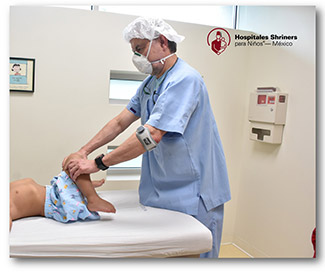Hip dysplasia in children
The Importance of Early Detection
Shriners Hospital is a pioneer in Latin America and has a hip clinic aimed at patients 3 months of age and older with this pathology. Regarding the subject, we interviewed Dr. Roberto Galvan, who is the Chief of the teaching department of the hip pathology clinic, so he could speak about the importance of an early diagnosis.
How to detect infantile hip dysplasia?
Doctor Galván says that it is possible to detect the condition when changing the patient's diaper “when changing the child’s diaper it is possible to notice there is a limitation when spreading the child’s legs, that is, when performing an abduction, you will be able to notice a clicking sound. When this is unilateral, meaning on one side, we notice that the legs don’t spread well, or when lifting the lower limbs, we observe an asymmetry of the folds of the legs and buttocks. It is also possible to confirm the diagnosis by ultrasound, which is highly efficient before three months of age,” he said.
Risk factors:
- Genetic predisposition.
- Mechanics: Oligohydramnios (low amniotic fluid), first pregnancy, uterine abnormalities, breech presentation, that is, if the patient was born from a pelvic or sitting position. In this case, it is practically mandatory to perform an ultrasound, or an X-ray, if after three months, to rule out this pathology.
- Cultural behavior: swaddling the baby with legs together as a “taco.” If it was an incipient condition, this position worsens the patient's problem.
This pathology is more common in women, with a prevalence of 8 to 1, more frequent on the left side, than bilaterally, or than on the right side. It occurs mostly in those considered white.
“Unfortunately, here at the Hospital we have cases that were not detected in time and the treatment must be surgical. The type of treatment that will be carried out depends on the age of the patient. That is why it is so important to detect the condition in time, because the treatment is abysmally different and so is the prognosis.”
What are the treatments applied at the Shriners Hospital to treat this condition?
When detected early, it is possible to treat the condition with conventional methods, such as the Pavlik harness or abductor cushions. If the patient's problem was not detected and the hip is totally dislocated, surgical treatment is required, “these are laborious and complicated surgeries, and here at the Shriners Hospital is the place where most of them are performed,” explains Dr. Galvan.
If this condition is not detected in a timely manner, and it is only perceived as something “insignificant”, it can be a patient who, as an adolescent or young adult, may present coxalgia, or early hip pain, which can result in a hip joint replacement. It has been described that patients who need a hip replacement before the age of 60, had an “insignificant” hip pathology and that is manifesting as early osteoarthritis or early hip wear.
Patient recovery
When the patient has had to undergo surgery, he/she must be immobilized for 6 to 12 weeks, after which a rehabilitation process is required that can last from 2 to 6 months. In some cases, a second operation is required.
The importance of early diagnosis
“What we try to do is diagnose the condition at an early age. In the event of any suspicion, it is necessary to take an X-ray and prevent the condition from progressing, since these are pathologies that require follow-up for the rest of the patient's life if surgery is performed,” Dr. Galván shares.
The Message
“If you have any doubts about abduction limitation, asymmetry of folds, or hearing the ‘click’ when moving the child's legs, go for an ultrasound if it is before three months of age, or an x-ray if it is older than three months, but do not set the issue aside, go to the doctor and insist on getting answers to your questions,” concludes Dr. Galvan.

Keep In Touch
Join our mailing list to stay up to date on everything that's happening at Shriners Children's.
